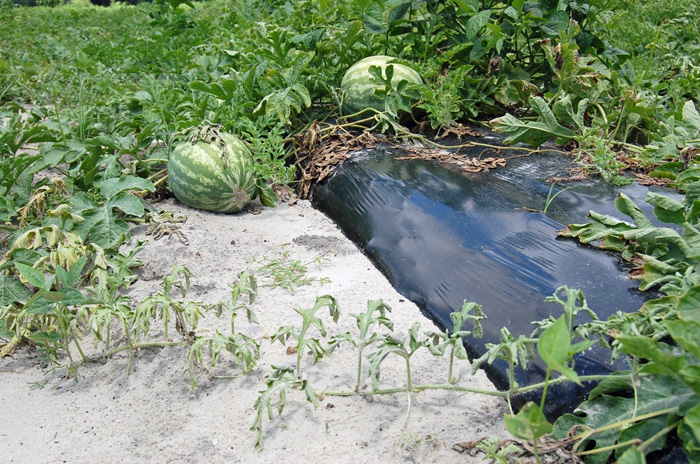Authors: Tatiana Sanchez, Mathews Paret, Joshua Freeman, and Nicholas Dufault
Fusarium wilt of watermelon (Figure 1) is a soil-borne, fungal disease that can affect watermelon plants anytime from seed to harvest. It has been a problem for many Florida producers since its first reports back in the early 1980’s. Typically, this disease is managed with long rotations (6 years or more) to a non-cucurbit crop and through host resistance. Finding “new” land for watermelon production is increasingly difficult and host resistance is available for only two out of four races of this pathogen. Thus, novel techniques are needed to adequately manage this disease in the future.
Disease management starts with proper identification of the pathogen. The main symptom of this disease is wilting of the whole plant or just one of the lateral runners of the vine (Figure 2.A). Other symptoms include reduced growth, chlorosis, and appearance of nutritional deficiencies. During the initial stages of the disease, vines may look droopy during the hottest hours of the day but recover after temperature has decreased. Wilting is usually first seen on the leaves near the base of the plant (Figure 2.B), but as the disease progresses this wilting will move out towards the tips (Figure 2.C). After vines grow past the plastic of the bed, Fusarium wilt hotspots can be noticed by a lack of significant ground cover (Figure 2.D). Accurate identification of Fusarium wilt is important to develop a quality management plan for the disease.
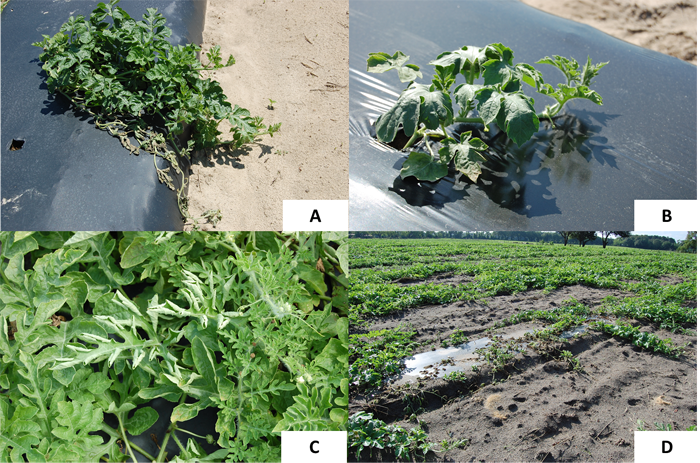
Figure 2. Fusarium wilt symptoms and evidence of the disease in the field. A. One wilted runner still attached to main, seemingly unaffected, vine – Quincy, FL. B. Older leaves exhibiting initial symptoms of wilting two weeks after transplanting – Citra, FL. C. Apical leaves on mature vine showing initial symptoms of wilting – Madison Co, FL. D. Open spaces caused by death of vines infected with Fusarium wilt – Gilchrist, FL.
Reports of this disease in Florida and throughout the southeast have increased during the last decade indicating a need to adjust current management strategies. Trials examining the efficacy of various fungicidal products on the management of Fusarium wilt were conducted from March to July at the Plant Science Research and Education Unit in Citra, FL and the North Florida Research and Education Center in Quincy, FL. Both drip and drench product application methods were tested in this study. The drench application was conducted once, one week after transplanting whereas drip applications were made twice, one and two weeks after transplanting. Even though most products produced similar trends between the two application methods, results indicated that drench applications offered a better disease control than the drip method (Figure 3).
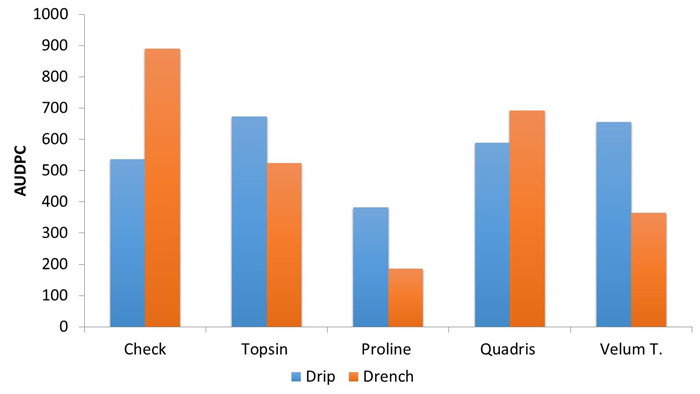
Figure 3. Area under disease progress curve (AUDPC) of drip and drench trials conducted at the University of Florida Research and Education Unit at Citra, FL. AUDPC was calculated from six severity ratings taken weekly from 4/15/15 to 5/12/15. AUDPC summarizes disease intensity over time; lower area values indicate that less disease occurred throughout the trial. Fungicide treatments consisted of an untreated check (water only), Topsin® 4.5 FL (10 fl oz/A), Proline® 480 SC (5.7 fl oz/A), Quadris® Flowable (15.5 fl oz/A) and Velum® Total (18 fl oz/A).
While all the products tested in the drench trial had lower disease values than the untreated plots, only the Proline® 480 SC treatment was observed to be statistically different in both reducing disease severity and saving yield (Figures 3, 4, and 5). The other treatments varied in their ability to control disease and save yields among trials and locations (Figures 3 and 4). These results indicate that it may be possible to manage Fusarium wilt with various chemical products, however, more information is needed on the timing and method of application of these products.
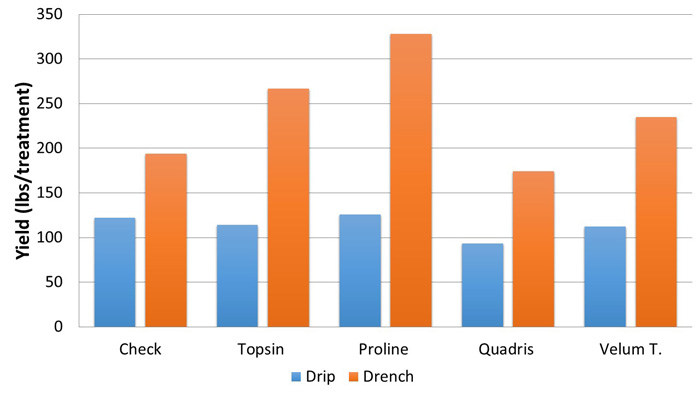
Figure 4. Mean watermelon yield comparison between drip and drench application of fungicides. Experiments were conducted at the Plant Science Research and Education Unit in Citra, FL. Plots consisted of one row 30 ft long replicated four times. Fungicide treatments included an untreated check (water only), Topsin® 4.5 FL (10 fl oz/A), Proline® 480 SC (5.7 fl oz/A), Quadris® Flowable (15.5 fl oz/A), Velum® Total (18 fl oz/A) and Taegro® ECO (5.2 oz/A).
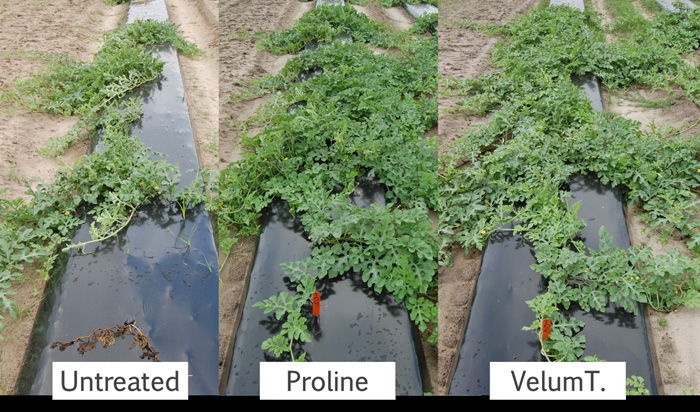
Figure 5. Example plots from the 2015 drench trial in Citra, FL showing plant vigor five weeks after transplanting of two different fungicides. The treatments here presented consist of an untreated check (only water), and a one-time drench application of Proline® 480 SC (5.7 fl oz/A) and Velum® Total (18 fl oz/A).
In summary, it was observed the efficacy of chemicals in controlling this disease is limited. The data from this study indicate that a drench application of effective fungicidal products (i.e. Proline® 480 SC) could be a useful component of a Fusarium wilt management plan. However, the application of fungicidal products through drip lines does not appear to be an appropriate technique, especially early in the season. A combination of multiple tactics for disease management must be addressed to prevent crop loss. Thus, an integrated strategy that includes crop rotation, host resistance and additional strategies such as fungicides, can help improve disease management programs for this devastating pathogen.
Further work is being conducted on this disease at the University of Florida in collaboration with researchers at the University of Georgia and Clemson University. This research will examine further the use of chemicals and fumigants in the management of this disease and how grafting to resistant rootstock will help improve disease control. In general, management of Fusarium wilt will require a diverse integrated approach to successfully control this devastating disease and the results from these studies will help increase the options available to producers. If you observe this disease affecting your field, please contact your local extension office and/or submit plant samples to the vegetable extension plant pathology lab or Plant Disease Clinic to confirm diagnosis.
- 2025 End-of-Season Florida Peanut Disease Notes - October 24, 2025
- Southern Rust Confirmed in the Florida Panhandle – June 2025 - June 6, 2025
- Stay Ahead of Disease with the Spore Report: A New Tool to Assist with Potato and Watermelon Management - April 11, 2025

